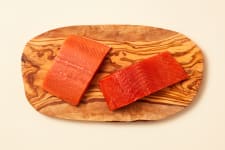After record low numbers of chum and king salmon, this season’s closing of commercial, subsistence, and sport fishing on the Yukon River has affected the lives of many in nearby communities. At Wild Alaskan Company, while we don’t currently source fish in the Yukon, nor do we currently sell king or chum salmon, the impact this closing and sudden drop of the salmon population has had on the Alaskan fishing community at large is a cause for concern.
The closure and its subsequent consequences brings up a lot of questions, many of which don’t have clear-cut answers. And without answers, we believe it’s best to be cautious, and learn from the people of Alaska.
Here’s what we know, and what we don’t know.
Why is this happening?
The truth is, while there is speculation on the cause of the Yukon salmon population drop, we don’t have any clear answers yet. Many outlets are sourcing climate change and rising sea temperatures as a culprit, and others are pointing towards bycatch. While these may be the cause or even factors in the low escapement, it’s too soon to identify the root problem or offer any kind of solution.
But no matter the cause, it’s important to proceed with caution. The precautionary principle warns us that the world should not wait for science to rule one way or the other when determining if we should be cautious to protect the earth. We agree that fishing should indeed pause — according and thanks to the sustainable yield principle written into Alaska’s state constitution — until the populations can rebound and be self-sustaining.
Sometimes escapements, or the number of salmon returning home to spawn each year, ebb and flow. Currently, while the Yukon is at record lows, Bristol Bay, for example, is seeing record highs. In both cases, the state law remains the same, and prevents overfishing during a boon, and unfortunately, in the case of the Yukon, is pausing all fishing to give the populations a chance to regenerate.
What about the local communities in the area?
Wild Alakan Company founder and CEO Arron Kallenberg grew up fishing in Alaska, and his dedication to preserving its ecosystems and fishing traditions runs deep. He’s seen a lot of variation in fish populations in Alaska, following the highs and lows over the years, and has watched how fishery managment responds to these fluctuations. Sometimes, fisheries must be closed when population numbers are low. Some fisheries reopen and some are still struggling to regain their populations. When this happens, local communities do have to adapt to closures.
Subsistence-based communities have adapted to changes in the harvests for years and are still doing so today. A constant and consistent type food source is a modern concept. This rise and fall has been seen by the local people of Alaska for centuries, and although a current hardship in the Yukon area, this reality has always been a part of living in concert with nature. Adapting as necessary is a part of the landscape. But that doesn’t necessarily mean that in today’s times we should do nothing.
How are we moving forward?
“Fish, forests, wildlife, grasslands, and all other replenishable resources belonging to the State shall be utilized, developed, and maintained on the sustained yield principle, subject to preferences among beneficial uses.”
This sustainable yield principle, and the stewards who abide by it, have been the backbone of sustainable fishery management in Alaska.
As a public benefit corporation, it's part of our mission to help where and when we can. We continue to fund research to learn about the migratory patterns of salmon. One of the founding principles of Wild Alaskan Company is to operate in service of protecting the wild fish population for future generations to come. We’re on a mission to accelerate humanity’s transition to sustainable food systems. Without them, all is lost. Nothing is more important to us.






